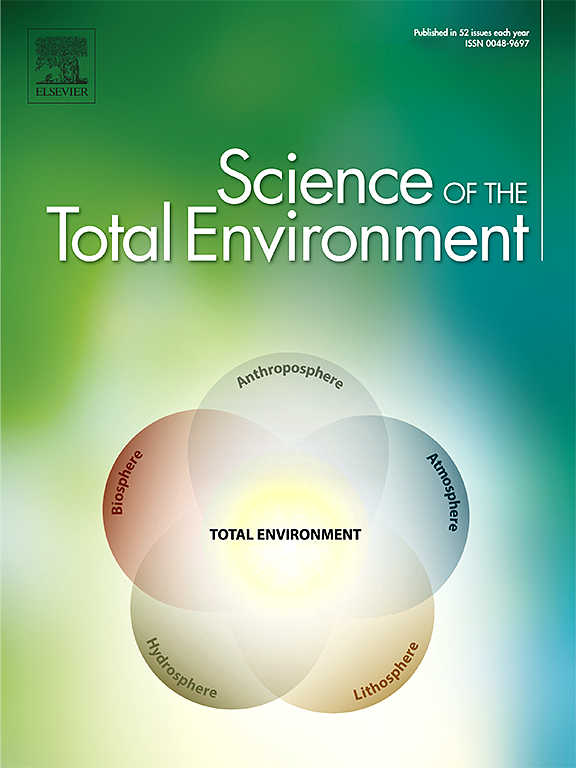中国0-6岁儿童血镉水平:一项全国性横断面研究。
IF 8.2
1区 环境科学与生态学
Q1 ENVIRONMENTAL SCIENCES
引用次数: 0
摘要
背景:Cd没有已知的生物学功能,并对人类健康构成重大风险。儿童尤其容易受到镉中毒的影响,因为他们的吸收率较高,而生物防御能力较弱。然而,中国0-6岁儿童的全国血镉水平(BCLs)仍不清楚。方法:采用多阶段分层整群抽样方法,对30,156名0-6岁的中国儿童进行代表性抽样。静脉血在无菌条件下采集。采用高灵敏度四极杆电感耦合等离子体质谱法(ICP-MS/MS)分析Cd水平。采用Kruskal-Wallis检验和卡方检验进行统计比较。在整个研究过程中保持了严格的质量控制。结果:儿童的几何平均BCL为0.146 μg/L。结论:我们对中国0-6岁儿童的bcl进行了评估,并报告了不同阶层儿童bcl的具体指标。观察到显著的区域差异,特别是在北部和南部地区之间。这些发现促使人们进一步讨论bcl的空间分布及其潜在原因。在此基础上,我们进一步提出了中国儿童bcl的参考值,并强调了在儿童bcl暴露较高的地区加强环境控制和修复的迫切需要。本文章由计算机程序翻译,如有差异,请以英文原文为准。
Blood cadmium levels of children aged 0–6 years in China: A national cross-sectional study
Background
Cd has no known biological function and poses significant health risks in humans. Children are particularly susceptible to Cd toxicity due to their higher absorption rates and weaker biological defenses. However, national blood Cd levels (BCLs) in Chinese children aged 0–6 years remain unclear.
Methods
We employed a multistage stratified cluster sampling method to obtain a representative sample of 30,156 Chinese children aged 0–6 years. Venous blood samples were collected under sterile conditions. High-sensitivity quadrupole inductively coupled plasma mass spectrometry (ICP-MS/MS) was used to analyze Cd levels. The Kruskal-Wallis and the chi-square tests were employed for statistical comparisons. Strict quality control was maintained throughout the study.
Results
The geometric mean (GM) BCL among children was 0.146 μg/L. Children in eastern and southern China had significantly higher BCLs compared to those in central, western, and northern regions (P < 0.001). Rural children showed higher BCLs compared to those in urban areas (P < 0.001). Among provinces, children in Hunan and Guangdong had the highest BCLs.
Conclusion
We evaluated the BCLs in Chinese children aged 0–6 years and reported specific indicators of BCLs across various stratifications. Significant regional variation was observed, particularly between northern and southern regions. These findings prompt further discussion on the spatial distribution of BCLs and the potential underlying causes. Based on our results, we further propose reference values for BCLs in Chinese children and stress the urgent need for enhanced environmental control and remediation in regions where children are exposed to higher BCLs.
求助全文
通过发布文献求助,成功后即可免费获取论文全文。
去求助
来源期刊

Science of the Total Environment
环境科学-环境科学
CiteScore
17.60
自引率
10.20%
发文量
8726
审稿时长
2.4 months
期刊介绍:
The Science of the Total Environment is an international journal dedicated to scientific research on the environment and its interaction with humanity. It covers a wide range of disciplines and seeks to publish innovative, hypothesis-driven, and impactful research that explores the entire environment, including the atmosphere, lithosphere, hydrosphere, biosphere, and anthroposphere.
The journal's updated Aims & Scope emphasizes the importance of interdisciplinary environmental research with broad impact. Priority is given to studies that advance fundamental understanding and explore the interconnectedness of multiple environmental spheres. Field studies are preferred, while laboratory experiments must demonstrate significant methodological advancements or mechanistic insights with direct relevance to the environment.
 求助内容:
求助内容: 应助结果提醒方式:
应助结果提醒方式:


